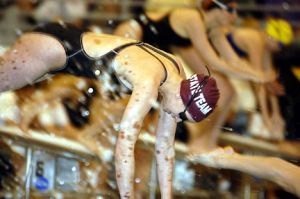 The inferior members of swimming or running relay teams – those athletes who fared poorest in individual races – showed the greatest gains when performing as part of a team, and those gains were even greater during final races as opposed to preliminary races.
The inferior members of swimming or running relay teams – those athletes who fared poorest in individual races – showed the greatest gains when performing as part of a team, and those gains were even greater during final races as opposed to preliminary races.
The new research from Michigan State University’s Deborah Feltz and Kaitlynn Osborn provides some of the first real-world support for the Kohler motivation effect, which describes how less capable individuals perform better when performing a task with others as opposed to individually.
The researchers also measured athletes for evidence of the social loafing effect, or when people exert less effort to achieve a goal when working in a group. While no statistically significant evidence was found, the performances of superior group members tended to be slower in relay races.
The findings, based on two separate studies of archival performance data from college and high school athletes, appears in the current edition of the journal Sport, Exercise, and Performance Psychology. Osborn, a doctoral student in the Department of Kinesiology, was the lead author of the study, working with Feltz, university distinguished professor and former chairperson of the department.
“Researchers for years have been attempting to understand the complex nature of motivation in sport, partly to find a way to increase athletes’ motivation to perform,” Osborn said. “Our findings show weaker team members are more motivated when working with others than when working alone.
“These studies provide some of the first real-world examples of the Köhler motivation gain effect and a trend towards a social loafing effect within the same group.”
The study also revealed female athletes were more affected by indispensability pressures, as they performed better when being viewed as an important member of the team. Males tended to be more motivated by social comparison, meaning they performed better when compared specifically with competing athletes.
The first study examined motivational gains and losses, as measured by performance, of 68 athletes on NCAA 200-yard freestyle swimming teams. The second study looked at the same measures, but in 156 athletes competing on high school track and field teams.
Feltz said coaches should be aware that both motivation gains and losses can occur in the same group and be prepared for those results.
“Key motivation strategies include making individual contributions visible and holding individuals accountable for what they do for the team,” she said. “Also, coaches need to tailor these strategies to individual athletes to best meet their needs when necessary.
Feltz said the next step is to study performance differences and motivation over the course of an athletic season and include other sports involving both an individual and a team component.




